Fairport Harbor Lighthouse & Museum

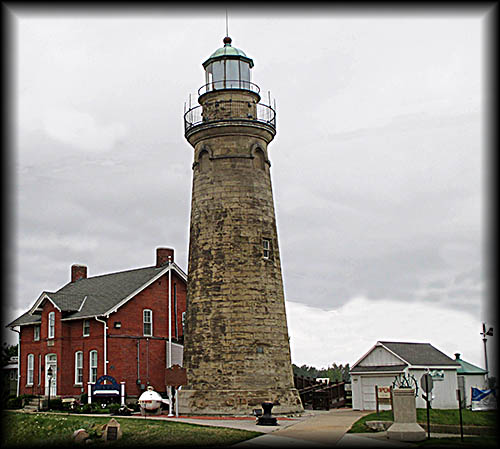
An exterior view of the lighthouse and museum.
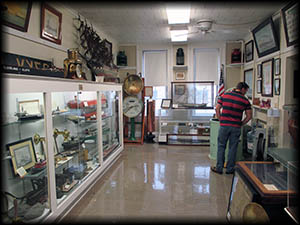
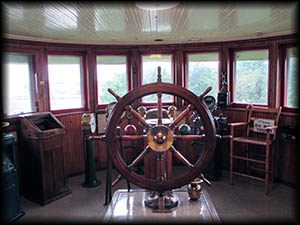
This is the pilothouse attached to the museum and taken from the Great Lakes’ ship Frontenac.
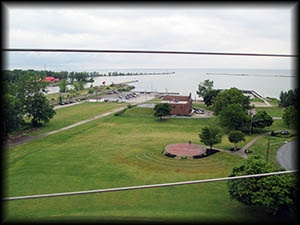
The view to the north from the deck of the museum’ s lighthouse.
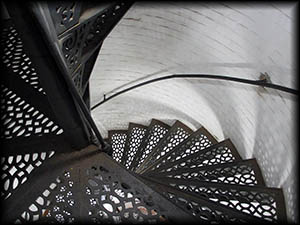
If you are the top of the stairs in the lighthouse, it is a long way down....
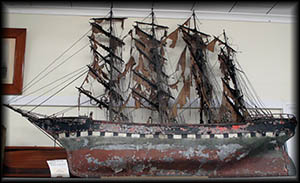
I would love to know more about this old metal model, but I didn’t see any information about it.

This is a large nugget of salt from the Morton salt mine beneath Lake Erie.
The Fairport Harbor Lighthouse & Museum stands along the southern shore of Lake Erie and on the east side of the Grand River in Fairport Harbor, Ohio. Unlike any of the other Great Lakes’ maritime museums in the state, this one has a lighthouse, a structure opened in 1871 that replaced an earlier one constructed in 1825. In 1925 the former shut down when the Coast Guard opened a new light- and keeper’s house complete with fog horn on a nearby breaker, and in 1945 the old one became the present museum.
Although small in size—aside from the lighthouse, the museum has just three main rooms and an attached boat house taken from the Great Lakes’ ship Frontenac—the museum comes jam-packed with artifacts of all types. Some of them, like a few Civil War pieces, have little to do with the history of the Great Lakes, but I suppose whoever put them there figured why waste a perfectly good historical piece? The large chunk of salt on display at first might also seem out of place, but it definitely belongs here. It came from Fairport Harbor’s Morton Salt Company mine beneath Lake Erie, which is still active today. Other pieces in the collection include some quite rare and unique items, including artifacts from the squadron of the American vessels that fought at the Battle of Lake Erie under the command of Oliver Hazard Perry. The museum also has a massive display of newspaper articles pertaining to local history you can flip through and read.
Although small in size—aside from the lighthouse, the museum has just three main rooms and an attached boat house taken from the Great Lakes’ ship Frontenac—the museum comes jam-packed with artifacts of all types. Some of them, like a few Civil War pieces, have little to do with the history of the Great Lakes, but I suppose whoever put them there figured why waste a perfectly good historical piece? The large chunk of salt on display at first might also seem out of place, but it definitely belongs here. It came from Fairport Harbor’s Morton Salt Company mine beneath Lake Erie, which is still active today. Other pieces in the collection include some quite rare and unique items, including artifacts from the squadron of the American vessels that fought at the Battle of Lake Erie under the command of Oliver Hazard Perry. The museum also has a massive display of newspaper articles pertaining to local history you can flip through and read.

I found the ship’s deck prism the most interesting item in the entire museum despite its seeming ordinariness. Why? I had never heard of such a thing despite having read everything I could get my hands on about sailing, its history, and stories about it. I learned shipwrights embedded these into the decks to allow natural light to filter into dark places where taking an open flame could ignite flammable materials such as gunpowder on naval vessels.
I like museums to have simple information tags so I can go about the business of looking at the items on display rather than spending all my time reading signs. And, to my delight, this museum has pretty sparse tags, although sometimes it takes this a bit too far. When, for example, I came across an intriguing model ship made of metal that looked as if had once set outside for a good number of years, I wanted to know more about its history but found nothing on display containing this information.
One of the oddest things the museum contains is a mummified cat. Yes, that’s right, a mummified cat. Found during the installation of an air conditioner, the ghost of this little beastie supposedly haunts the place. Other ghosts allegedly wander about as well, such as Samuel Butler, the lighthouse’s very first keeper, whose apparition one person claims to have seen at the top of the lighthouse. Whether an incorporeal version of him strolls about at night or not, in life he did more than just keep ships and boats safe by ensuring a shining light when needed. He also ran a station of the Underground Railroad, personally rowing slaves to Canada and freedom.
I like museums to have simple information tags so I can go about the business of looking at the items on display rather than spending all my time reading signs. And, to my delight, this museum has pretty sparse tags, although sometimes it takes this a bit too far. When, for example, I came across an intriguing model ship made of metal that looked as if had once set outside for a good number of years, I wanted to know more about its history but found nothing on display containing this information.
One of the oddest things the museum contains is a mummified cat. Yes, that’s right, a mummified cat. Found during the installation of an air conditioner, the ghost of this little beastie supposedly haunts the place. Other ghosts allegedly wander about as well, such as Samuel Butler, the lighthouse’s very first keeper, whose apparition one person claims to have seen at the top of the lighthouse. Whether an incorporeal version of him strolls about at night or not, in life he did more than just keep ships and boats safe by ensuring a shining light when needed. He also ran a station of the Underground Railroad, personally rowing slaves to Canada and freedom.
Going from the museum into the lighthouse involves a short outdoor walk, so while there, you can take look at two artifacts on display: a ship’s mast and a lifesaving car. The mast once belonged to the ship USS Michigan, a vessel which, according to the museum’s brochure, “was the first iron-hulled ship of the U.S. Navy.” A more verbose information tag about the lifesaver car didn’t exist might be useful, because just looking at it, I initially mistook it for a regular lifeboat and thought it absurd for anyone to get into this metal container and shut the hatch because doing so in anything but the coldest of weather would likely cause a person to roast if not suffocate. Upon closer inspection, I noticed it had loops attached to its top at its bow and stern, and only then did it dawn on me the Coast Guard used this as a cable car to bring people in from a wreck just of shore during a gale.
Upon entering the lighthouse proper, one will find themselves facing a metal spiral staircase of sixty-nine steps that makes a seemingly endless ascent into the sky. Because that stairs’ treads have holes to create better traction it lack risers, you can see through them pretty well, so if heights bother you, don’t go up. Instead let others with cameras do the climbing. One of my traveling companions and I made the ascent while a third did not for this very reason. You can go as high as the lower gallery and even walk out onto the deck, making your way completely around and enjoying the view.
From the deck you can see the aforementioned West Breakwater Lighthouse, but if wish to get a closer look at it once back on terra firma, you won’t be able to just walk to it. Unless you wish to swim across the Grand River through a busy shipping lane, you would do well to drive there instead because its sets on the river’s west side. Once at the breaker, you can walk out to the lighthouse but you can’t go into the keeper’s residence because a private person owns it and wouldn’t take kindly to strangers tromping about the place.🕜
Upon entering the lighthouse proper, one will find themselves facing a metal spiral staircase of sixty-nine steps that makes a seemingly endless ascent into the sky. Because that stairs’ treads have holes to create better traction it lack risers, you can see through them pretty well, so if heights bother you, don’t go up. Instead let others with cameras do the climbing. One of my traveling companions and I made the ascent while a third did not for this very reason. You can go as high as the lower gallery and even walk out onto the deck, making your way completely around and enjoying the view.
From the deck you can see the aforementioned West Breakwater Lighthouse, but if wish to get a closer look at it once back on terra firma, you won’t be able to just walk to it. Unless you wish to swim across the Grand River through a busy shipping lane, you would do well to drive there instead because its sets on the river’s west side. Once at the breaker, you can walk out to the lighthouse but you can’t go into the keeper’s residence because a private person owns it and wouldn’t take kindly to strangers tromping about the place.🕜
Inside the Museum